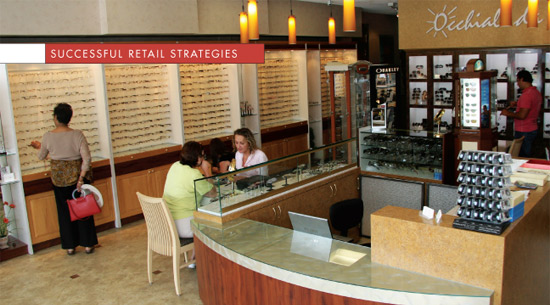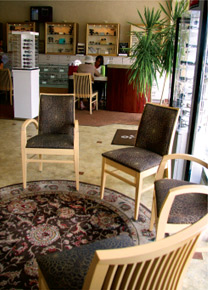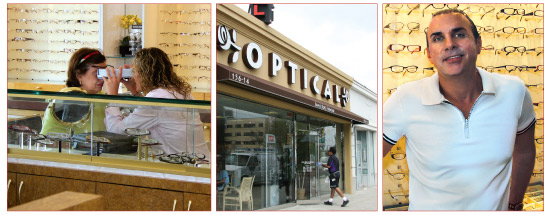


Imagine this: one day you are walking down a major thoroughfare in an old New York neighborhood not too far from Manhattan and you see a store—an optical shop—for the first time. “Are you new to the neighborhood?” you ask the owner.
“No,” he replies. “We’ve been in this location for the last 18 years.” As the owner explains that his store was recently renovated, you think, “Ah, yes, you were the caterpillar hiding under the branch, and now you are the beautiful butterfly...”
DYNAMIC DISPENSING
BEFORE AND AFTER
BEFORE 1,000 square feet
AFTER 1,780 square feet
BEFORE Maroon canopy on narrow storefront
AFTER Butt-jointed floor-to-ceiling glass extending the length of the storefront
BEFORE Reception near the back
AFTER Reception up front
BEFORE Sunwear potential unrealized
AFTER Sunwear shop within a shop
BEFORE One exam room
AFTER One exam room
BEFORE Handout posters and countertop placards
AFTER Flat screen TV running continuous video
BEFORE Fluorescent lighting
AFTER LED lighting
BEFORE Tangles of wires and piles of paper crowding work stations
AFTER Wires and cables run underground; laptops at every station
BEFORE Paper
AFTER On the way to paper-less
At a time when the economy was on the fritz and most of the country was feeling skittish about retailing in general, Jamie DeNaro decided to take a chance. When the space next to his tiny storefront on Cross Bay Boulevard in Howard Beach, N.Y., became available, he moved quickly, seizing the opportunity to enlarge his optical shop and reinvent his business.
“I wanted an absolute wow factor,” says the industry veteran. And judging by the before and after shots alone, he got wow and then some.
“The truth is, I didn’t really have a budget, but I knew what I wanted from the finished shop and I wanted to do it right. I wasn’t interested in simply buying new displays, I wanted someone to come in and create a whole new look—not a cookie cutter thing, but something that would be special.”
DeNaro hired a local architect to work on marrying the side-by-side buildings into a cohesive storefront. He also hired Barbara Wright Design to create a polished interior and brand identity. Over the course of six months, his team executed a flawless facelift and redesign, doing much of the construction at night and on weekends, allowing him to keep his business open throughout the remodel.
“I probably spent about $250,000 for everything,” says DeNaro. “We added a handicap-accessible bathroom, redid the ceiling, put in a new electrical panel, added more air conditioning and heat, created a singular glass storefront... I didn’t want it to look like an add-on. I wanted it to be done right, without cutting corners.”
“I believe his practice was at the point where if he didn’t expand or do something to improve it, he stood the possibility of going backward rather than forward,” says designer Barbara Wright. “I really felt responsible for getting maximum results for him.”
Wright admits to having fun with the design of the store’s interior. “It’s a predominately Italian neighborhood, one where people respond well to a little bit of glitz. We brought in tasteful elements and old world glamour with a modern edge. The response has been fantastic.”
One of Wright’s biggest challenges was maximizing the floor space and determining the ideal flow of traffic. “In the existing space, the layout was all wrong. Functions overlapped. Everyone was jammed together, stepping over one another. The layout didn’t work,” she says.
But with the addition of about 700 square feet, Wright was able to relocate the reception desk, improve storage, create a small workspace for minor repairs and—per DeNaro’s request—set up a separate sunglass shop within a shop. “I never wanted my clientele to go elsewhere for plano sunwear and now they don’t have to,” says DeNaro. “Since the remodel, our plano sunwear sales are up 20 percent.” Of his 1,000 piece inventory, about 250 to 275 frames are sun. “We always carried sunwear, but we were never able to merchandise it properly.”
Sun selection ranges from Vogue styles at $89 to Tag Hauer at $425. Ophthalmic frames include styles from Chanel, Tiffany & Co. and Dolce & Gabbana, as well as value brands covered by union-based health insurance allowances. “We had to be very careful with the inventory,” says DeNaro. “We didn’t want to scare our loyal customers or have them think they couldn’t shop here anymore.” And to that end, DeNaro is careful to point out that even with its new look, the store needed to be inviting, not intimidating.
DeNaro adds that his complete average sale is up about 20 to 25 percent since the remodel, hovering between $225 and $275 for frames and lenses. “We are more visible now,” he says. “And we’re getting a lot of new patients.”
Wright insisted that DeNaro get rid of the “noise”—promotional posters and countertop materials—and replace them with a flat screen TV that runs an endless loop of optical and fashion video. She also suggested incorporating a rose motif into the storefront as well as business cards and other correspondence. “The thing to remember about Barbara,” he says, “is that, yes, you are paying a design fee, but you are getting the whole package. She isn’t just bringing in displays. She’s creating a brand and an image that carries over into all aspects of the business.”
Wright adds, “He had to make a substantial investment in the store. It was necessary, but it will take him through the next 10, 15, even 20 years. We gave him a good design, so that it will look good over time. We don’t want him to have to remodel again in five years.”

It’s clear that the store’s look has longevity. Warm interior paint tones complement the custom cherry displays. The palazzo style limestone flooring is longwearing and easy-to-care for vinyl, and much of the interior lighting was switched over to LED. The butt-jointed glass storefront turned the entire brightly lit and beckoning interior into an oversized window display. “I leave my lights on until 4 a.m.,” says DeNaro. “It’s the most cost-effective advertising I could find.”
Though the neighborhood is still reeling from a slowed economy, Jamie Rose Optical is truly spreading its wings. “When times are good, you’ve already missed the boat,” says DeNaro. “We’re already seeing a return on the risk we took. In fact, when people realize that you are doing renovations—improving—they really appreciate it.” ■











